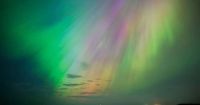Stunning visuals from the Northern Lights have captivated audiences in the UK, with one notable display filmed in Norfolk last weekend. Local photographer Simon Luckman captured the aurora borealis above Breydon Water and Cobholm rugby field on the night of March 22, 2025, staying out from 10:45 PM until midnight to document the breathtaking event. The resulting photos showcase vibrant pink and purple hues, a phenomenon that typically requires minimal artificial light for optimal visibility.
This recent sighting comes on the heels of heightened solar activity, which has made the Northern Lights increasingly visible across regions that rarely see them, especially in England. According to meteorological sources, a coronal mass ejection expected to arrive on March 23 is likely to enhance aurora visibility across parts of the UK, particularly Scotland and Northern England, where sky conditions permit.
Luckman's experience of the Northern Lights highlights the charm of nature's displays and the scientific processes behind them. The aurora borealis is caused by charged particles colliding with gases in Earth's atmosphere, typically visible near the magnetic poles due to the collision of solar particles with atmospheric gases. When such solar activity is heightened, like during solar storms, displays can push further south than usual, allowing more communities to catch glimpses of the dramatic light show.
As reports from the Met Office confirm, March 2025 has witnessed not just the Northern Lights but also a Blood Moon and an extraordinary lunar eclipse, creating a period of significant astronomical interest. The Royal Museums Greenwich elaborates on how solar storms eject clouds of electrically charged particles, which then travel millions of miles, eventually colliding with Earth to create stunning light displays. Tom Kerss, an astronomer at the Royal Observatory, explained, “These particles then slam into atoms and molecules in the Earth’s atmosphere and essentially heat them up.” This process leads to characteristic glowing displays that we observe as the Northern Lights.
For many in the UK, the chance to see such a spectacular natural phenomenon, especially in areas farther south, often relies on the right conditions—dark, clear skies away from urban light pollution. The Met Office has noted that aurora sightings might still be possible during this week, with forecasts indicating another chance for visibility on March 25, particularly when a coronal hole fast wind brings further geomagnetic activity.
In fact, according to their forecast, the best period for viewing the Northern Lights could actually fall around Tuesday night, March 25, with potential peaks around midnight into March 26. There’s even the chance that displays might continue into March 27, further extending the visual festivities for eager stargazers.
The increasing frequency of these sightings across the UK also reflects a broader trend tied to the solar cycle's peak activity level, which is expected to encourage such captivating views for approximately another year. Enthusiasts are encouraged to keep an eye on weather conditions and solar activity to increase their chances of witnessing this natural wonder.
Following the excitement from Luckman’s photos, local residents and nature watchers filled social media with their observations and photographs, expressing awe at the vibrant colors lighting up their skies. The Northern Lights, despite their mystique and rarity in the region, continue to inspire curiosity and wonder, echoing the timeless fascination humanity has with the cosmos.
As interest in these captivating displays rises, it is critical for enthusiasts and observers to consider factors like weather conditions and geographic location. The Met Office aims to provide timely updates on solar activity and aurora forecasts, making it easier for potential viewers to plan their stargazing outings.
As we embrace spring—a time when the northern hemisphere is favorably aligned with solar winds—the chances for such extraordinary phenomena only increase, fueling hopes for more sightings in the coming weeks. Whether you're armed with a camera like Luckman or simply looking up with your naked eye, the magic of the Northern Lights is an experience that promises to captivate everyone lucky enough to witness them, highlighting the beauty and complexity of our natural world.



